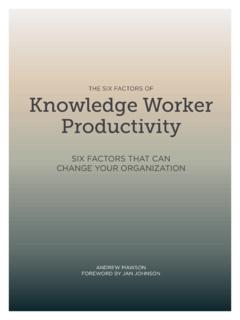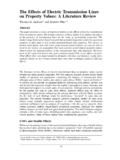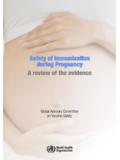Transcription of Ergonomics of seated movement A review of the …
1 Humanics ErgoSystems, Inc. Specialists in Ergonomics Ergonomics review . Ergonomics of seated movement A review of the scientific literature Considerations relevant to the Sum chair written for Allsteel by Rani Lueder, CPE. Humanics ErgoSystems, Inc. June 1, 2004. Certificant, Board of Certification of Professional Ergonomists Mail: Box 17388 Encino, CA 91416-7388. Ph: (818) 345-ERGO Fax: (818) 705-3903 Ergonomics review of the research From Corlett and Eklund (1984) How does a backrest work? Graphic used with permission Humanics ErgoSystems, Inc. Ergonomics review of the research .. Table of Contents Ergonomics AND THE 1. Summary .. 1. Overview .. 1. We need to move .. 2. Not moving is harmful .. 2. and contributes to backpain and injury .. 4. as well as leg swelling (edema) .. 5. Yet all movements are not the same .. 6. Unsupported sitting .. 7. Forward-oriented movements .. 8. Twisting / rotation / bending movements.
2 9. Sitting and seating .. 12. What happens when we sit? .. 12. Relaxed sitting flattens (flexes) our lumbar spine .. 12. Dynamic backrests promote continuous 15. Unsupported sitting (upright) .. 16. Support forward and back movements from centered 17. Reclined sitting (relaxed).. 17. 19. 19. References .. 20. About Rani Lueder, CPE .. 30. Humanics ErgoSystems, Inc. Ergonomics review of Sitting and Movements Page 1. Rani Lueder, CPE. Ergonomics and the Sum Summary Over the last two decades, our focus has gradually shifted from identifying the best single sitting posture towards a more movement is dynamic view of sitting and movement . essential, but While this emphasis on movement has helped avoid ergonomic movements are not risk factors, it also confused the issues. movement is critical, alike. Some should but it is not the only consideration. Taken to extremes, a strict even be avoided. emphasis on movement may even introduce new risk factors.
3 Movements are not the same; we ought to avoid some movements. This paper describes research relevant to movement and its implications for sitting and seating. These research dimensions include: 1. Why movement is so important. 2. Why different movements are not equal. 3. Selected seat design considerations. Overview As in all fields of science, our assumptions about sitting reflect changing paradigms in the research that shape the questions we ask and how we interpret its findings. For most of the last century, ergonomists widely assumed that we should sit upright (Staffel, 1884; Hooton, 1945; Akerblom, 1954). This emphasis on what Dainoff (1994). described as the cubist posture (with 90 knee, torso and elbow positions) aimed to prevent ergonomic risk factors that lead to discomfort and health disorders. The late 1980's saw a recognition that office work is more hazardous than had been believed and that constrained sitting postures can cause health disorders, particularly when other risk factors are present ( , NIOSH, 1997).
4 While movement is critical, this emphasis on movement for its own sake sometimes takes extremes. The drumbeat that we need to move has heralded new products that may contribute to awkward, unstable and unsupported postures. At times, health professionals also worsen the situation by maintaining that awkward and unstable postures are fine if users change positions from anything, to anything. This is not to downplay the importance of movement . movement is essential. Rather, the aim of this paper is to revisit these assumptions. Humanics ErgoSystems, Inc. Ergonomics review of Sitting and Movements Page 2. Rani Lueder, CPE. We need to move We have long known that constrained sitting is bad for our health ( , Adams and Hutton, 1983; Duncan and Ferguson, 1974; Eklund, 1967; Graf et. al, 1995; Hunting, et. al, 1980 and 1981; Hult, 1954; Langdon, 1965; NIOSH, 1997). In 1777, Ramazzini described hazards of constrained sitting among writers: Now 'tis certain that constant sitting produces Obstructions of the Viscera, especially of the Liver and Spleen, Crudities of the Stomach, a Torper of the Leggs, a languid Motion of the refluent Blood and Cacbexies.
5 In a word, Writers are depriv'd of all the Advantages arising from moderate and salutary Exercise.. More recently, a report by the National Institute of Occupational Safety and health (NIOSH, 1997) summarized research demonstrating a relationship between awkward and constrained postures and musculoskeletal disorders. Constrained postures increase discomfort and health risks ( the review by Aaras et al, 1997). Videman et al. (I990) found that both sedentary work and heavy physical work were associated with abnormalities of the spine1, but the relationship was particularly strong for sedentary work such as in the office. Static seating postures cause discomfort. Graf et al. (1993, 1995) reported more discomfort and chronic disorders among workers who sit in fixed postures. movement reduces these risks (Aaras et al, 1997; Kilbom, 1987). It is difficult for us to tolerate unsupported and static seated postures for more than a short while (Reinecke et.)
6 Al., 1985). When allowed to move freely, people are usually in constant motion (Branton, 1967, 1969; Jurgens 1980). Sitters tend to cycle through postures over the day (Bhatnager et al, 1985; Branton and Grayson, 1967; Fleischer et al, 1987). People tend to develop unique patterns of seated movements (Fleischer et al, 1987;. Jurgens, 1980; Ortiz et al, 1997) - which Fleischer (1987) compared to individual handwriting styles2. Unfortunately, intensive computer work diminishes opportunities to change postures and move (Grieco, 1986; Waersted and Westgaard, 1997). Not moving is harmful 1. These researchers studied disc degeneration in 86 cadavers. They described abnormalities such as disc degeneration, end-plate defects and osteoarthrosis of the facet joints of the vertebra. 2. That is, as a sequence of actions thought to be produced by an internalized specification of commands that indicates which muscles shall act at what time and what intensity.
7 Humanics ErgoSystems, Inc. Ergonomics review of Sitting and Movements Page 3. Rani Lueder, CPE. We have long known that constrained sitting is uncomfortable. Static postures contribute to a broad range of chronic disorders ( , Hunting et al., 1981) that include joint impairments such as arthritis, inflamed tendons and tendon sheaths, chronic joint degeneration (arthroses), muscle pain (Grandjean, 1987), impaired circulation and tissue damage (Kilbom, 1986). Static and constrained postures interrupt blood flow in The effect of static postures direct proportion to the muscle loads (Grandjean, 1987). magnify over time. Muscle oxygenation reduces with fairly low loads3 (McGill Kumar wrote, an and Hughson, 2000). At sixty percent of maximum force accumulation of residual ( , working with elevated arms), blood flow is virtually strain over years may set occluded (Grandjean, 1987). the stage for injury even if Static postures reduce our effectiveness4, causing us to stress does not rise move more often5, (Bhatnager et al6, 1985; Fenety et al, extraordinarily.)
8 The latter is 2000; Jurgens, 1980) and to move into postures due to a progressive (Bhatnager et al, 1985) that we know to be harmful reduction in stress (Andersson, 1980; Andersson et al, 1974a, 1975, 1986; tolerance capacity . Bhatnager et al, 1985). Some researchers maintain that such damaging effects are more related to a "lack of physical variation" than inactivity (Bendix 1994; Winkel and Oxenburgh, 1990). That is, the actual lack of variety of postures is more hazardous than the sedentary nature of the work. 3. These researchers found a reduction in tissue oxygenation of the lumbar extensor muscles with as little as 2% of Maximum Voluntary Contraction (MVC). 4. Bhatnager et al (1985) reported that the percentage of errors increased from less than 2% to more than 8% over the three hours' of sitting, which they attributed to less effective scanning patterns. Between the best and worst workplace conditions, performance increased from about 4% to about 6% errors.
9 They wrote, subjects appeared to realize that their performance was getting worse and increased their stopping times in an (unsuccessful) effort to compensate.. 5. Such as by fidgeting. 6. Bhatnager et al (1985) wrote, The frequency and severity of body part discomfort increased with time on task, as did frequency of postural Frequency of postural changed increased by more than 50% over the three hours and such appear to be a sensitive indicator of postural stress.. Humanics ErgoSystems, Inc. Ergonomics review of Sitting and Movements Page 4. Rani Lueder, CPE. and contributes to backpain and injury More than seventy percent of people older than 40 experience intermittent back pain. Our sitting habits affect our risk of back pain ( , Bendix 1994; Kelsey 1975b). Kelsey (1975b) found that sitting more than half the time at work was associated with herniated discs in those older than 35. People often assume that back pain is caused by short-term (acute).
10 Events such as accidents. Yet though slips and falls certainly injure, research suggests long-term The herniated lumbar spine, from two directions (low-level) chronic stressors are at (Slavin and Raja, 2001). least as important. That is, fixed postures are as likely to lead to disabling back pain as heavy manual work such as construction. Constrained postures can cause chronic degenerative alterations of the cervical, thoracic, and lumbo- sacral areas of the spine (Graf et. al. 1995; Hunting et. al., 1980; Occipinti et. al., 1987; Polus et. al., 1985). Progression of disc herniation (Bendix, 1994). Insurance and bank employees, who commonly sit in static positions for long periods, are likely Fixed postures are as to develop very high levels of intervertebral disk immobility likely to lead to (Wood and McLeich, 1974). disabling back pain as heavy manual work One reason that it is so important to move is that after the such as construction.











